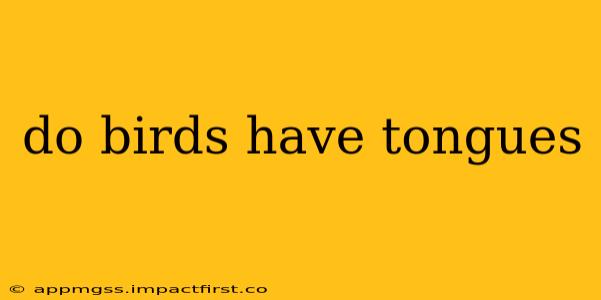Yes, birds do have tongues! While they might not look exactly like the tongues we're used to seeing in mammals, they are a crucial part of a bird's anatomy, playing a vital role in feeding, preening, and even vocalization. This comprehensive guide will explore the fascinating world of bird tongues, answering common questions and debunking some myths.
What do bird tongues look like?
Bird tongues are surprisingly diverse, varying greatly in shape, size, and structure depending on the species and its diet. Some are short and stubby, while others are long and slender, even brush-like or fringed. The texture can also differ significantly, ranging from smooth to spiky or even barbed. For example, hummingbirds possess long, tubular tongues perfect for extracting nectar, while woodpeckers have spiny tongues designed to extract insects from crevices in trees. The variation in bird tongues is a testament to the remarkable adaptability of avian evolution.
How do bird tongues work?
While the appearance varies, the basic function remains consistent across most species. The tongue helps birds manipulate food, guiding it down their throat. Many species use their tongues to sense the taste and texture of their food. Some birds, such as woodpeckers, use their tongue to capture prey. The tongue is also instrumental in preening, helping birds clean and maintain their feathers. Finally, in some species, the tongue plays a role in vocalization, although this is less prominent than its role in feeding.
Do all birds have the same type of tongue?
No, absolutely not! The diversity in bird tongues reflects the incredible variety of diets and feeding strategies found in the avian world. Hummingbirds, as mentioned, have long, tubular tongues adapted for nectar-feeding. Woodpeckers boast long, barbed tongues that can extend far beyond the beak to extract insects from wood. Ducks have serrated tongues that help them filter food from water, while birds of prey have relatively short, strong tongues suited for swallowing large prey whole. This diversity is a captivating example of evolutionary adaptation.
What is the bird tongue made of?
Bird tongues are primarily composed of muscle tissue, allowing for a remarkable range of motion and flexibility. The surface of the tongue is covered in a thin layer of epithelium, and many species have specialized papillae (small projections) that contribute to their sensory capabilities or help them manipulate food. The exact composition can vary slightly depending on the bird species.
Can birds taste with their tongues?
Yes, birds can taste with their tongues, although their sense of taste is less developed than in some mammals. Taste buds are present on the tongue, although their distribution and number vary considerably between species. This is closely linked to their diet; nectar-feeding birds tend to have more taste buds than birds that consume whole prey.
Are bird tongues connected to their beaks?
The bird's tongue is situated within the lower jaw, and while not directly fused to the beak, it's closely associated with it, particularly in terms of its movement and coordination. The tongue's muscular structure allows for precise movements, even within the confines of the beak.
This exploration into the fascinating world of bird tongues highlights the remarkable diversity and adaptation found within the avian world. The shape, size, and function of a bird's tongue are directly related to its ecological niche and feeding habits, illustrating the power of natural selection.
